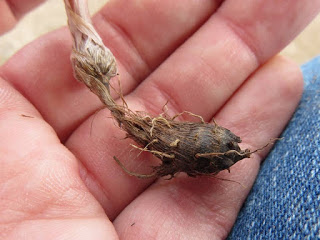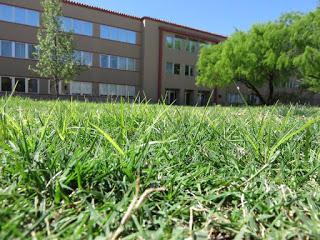September 15, 2018

Question:
This nut grass is taking over my yard. Please help.
- Lori D., Las Cruces, NM
Answer:
Many of us are familiar with the late, great nutsedge invasion of our garden beds, lawns, fields, and orchards this time of year. NMSU Extension Weed Specialist, Dr. Leslie Beck, explains how to distinguish between sedges and grasses: Sedges look very similar to grasses, but they are in a completely different family (Cyperaceae vs. Poaceae). When you pull away the leaf blades of grass plants, the remaining central stalks (aka culms) are just compressed leaf sheaths. So, a cross-section of a grass culm is hollow. Sedges tend to have solid culms that are distinctly triangle-shaped. This can be easily observed by rolling the base of the stalk back and forth between your thumb and forefinger to see if it feels edgy, like a triangle. Hence the old adage “sedges have edges.”

Yellow nutsedge (Cyperus esculentus), also known as “chufa,” and purple nutsedge (Cyperus rotundus) are the most common sedge species in our area. Dr. Beck shared some tricks for determining which one is taking over your yard:
- Look at that the tip of an uncut leaf blade. The tips of yellow nutsedge are going to be much sharper and pointed than those of purple nutsedge, which come to a relatively short and blunt point.
- Another thing to look for on yellow nutsedge is a very pronounced midrib in the leaf blade, almost giving the leaf itself a slight triangle shape.
- The leaves of yellow nutsedge may have a slightly yellowish color to them (hence the name), but that is not always a definitive identification characteristic because they can appear very dark green.
- Finally, the seedheads of yellow nutsedge are very light, almost yellowish in color, while purple nutsedge is very dark with a dark brown/purplish color.
But we don’t recommend you wait around to see what color the seedheads are going to be. The sooner you pull those sedges, taking care also to remove their little goober roots, the better.
Nutsedges are a major pest for all kinds of growers across the state. This is partly because they reproduce both by seed and by tubers (nutlets) that break off all too easily when you try to pull them up from the soil. If left in the ground, nutlets will regrow after the aboveground portions have been hoed, mowed down, or pulled with too much haste. Herbicides that are used to control weedy grasses in field crops and landscapes are ineffective on nutsedges. Just because they’re graminoid (grass-like) doesn’t mean the herbicide will work the same on sedges.

On top of that, many herbicides that work on weeds like dandelions won’t work on sedges because sedges are not broadleaf plants either. Generally, herbicides are more effective at stopping underground nutlet regrowth when applied to younger, actively growing plants. Even then, herbicide applications will be needed for several seasons in a row. Always be sure to read and follow herbicide labels carefully. For more recommendations on nutsedge identification and control, contact your county Cooperative Extension Agents and visit the Desert Blooms blog.
No matter how you try to handle it, this weedy problem is persistent. One way to outsmart nutsedges is to shade them out by getting your desired crop established as quickly as possible. My preferred control method is to attack earlier in the season when they’re still small by loosening moistened soil with a trusty hand tool and pulling each plant up carefully to get as many nutlets as possible. Then revisit those spots in the following weeks to pull up any newly sprouted sedges.
Yellow nutsedge tubers are edible and are even grown as a crop in some parts of the world. Another common name for them is “earth almond.” Horchata, the drink commonly made using rice water, vanilla, and cinnamon, was originally made by soaking yellow nutsedge tubers and called horchata de chufa. Purple nutsedge tubers are known to be more bitter, but they’re technically edible too. Try them and let me know what you think. That’s what I call “livin’ on the sedge.”

Marisa Y. Thompson, PhD, is the Extension Horticulture Specialist, in the Department of Extension Plant Sciences at the New Mexico State University Los Lunas Agricultural Science Center, email: desertblooms@nmsu.edu, office: 505-865-7340, ext. 113.
Links:
For more gardening information, visit the NMSU Extension Horticulture page at Desert Blooms and the NMSU Horticulture Publications page.
Send gardening questions to Southwest Yard and Garden - Attn: Dr. Marisa Thompson at desertblooms@nmsu.edu, or at the Desert Blooms Facebook page.
Please copy your County Extension Agent and indicate your county of residence when you submit your question!